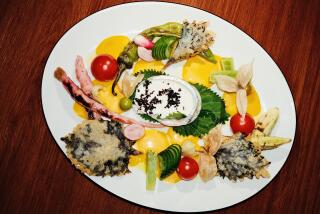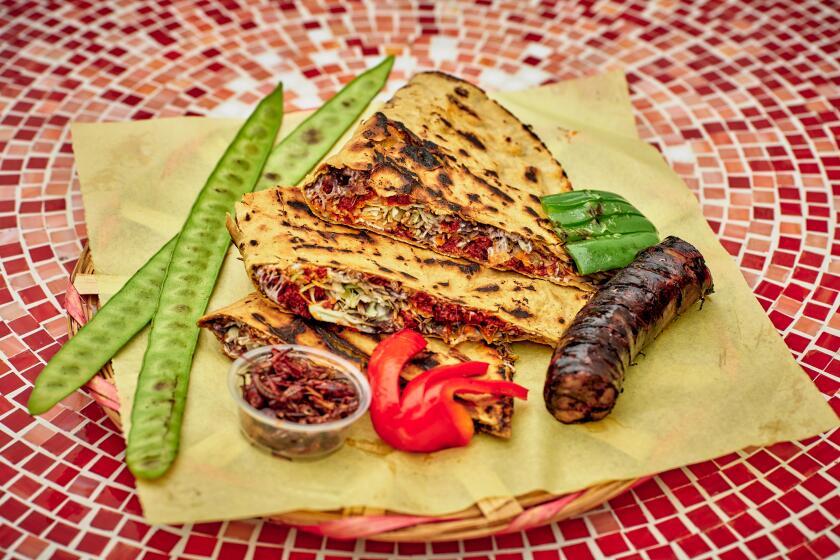A Paris afternoon in a tall glass
It’s a well-known fact that the French know how to enjoy life much more than anyone else. Their habit of relaxing over an aperitif before dinner is proof of it.
When your average Jean sidles up to the zinc bar for an apero (as the aperitif is fondly called) at his local boite, more often than not, it will be pastis. In France, pastis has no snob appeal; it’s a drink of the people, as popular among construction workers as university professors.
And why not? To those who know its charms, pastis -- known to most Americans as Pernod or Ricard -- is irresistible. The flavor is anise, accented by herbs and spices such as fennel, cardamom, cloves, nutmeg and licorice root. It’s slightly sweet, but by no means cloyingly so. If you adore black licorice, you’ll probably fall in love with it.
Pastis is just the thing to pour as the sun is setting, when you’re starting to think about dinner but want to relax first, hang out with friends, unwind.
Lately, artisanal pastis are all the rage in France, with small producers macerating fresh herbs in their concoctions to marvelous effect. A California distiller, Domaine Charbay in Napa Valley, started producing one five years ago when Susan Karakasevic, whose family owns the distillery, fell in love with artisanal versions while on vacation in France. Yet for the most part, the aperitif hasn’t made it onto the radar of even the most gastronomically inclined Americans.
As aperitifs go, pastis may be the most evocative -- especially if you’re someone who came of age in Provence. “When you hear the word ‘pastis,’ you hear the word ‘summer,’ at the beach or the ocean,” says Alain Giraud, chef at Bastide. Giraud spent much of his life in Nimes, prime pastis territory, as is the rest of the south of France. “You smell it and you smell the south,” he says. To an American such as myself, it evokes, well, France -- and that’s good enough for me.
Part of the appeal is the presentation. Pastis comes in a pretty palette of colors, from pale Tuscan orange to intense yellow-green. The bartender pours it in a cylindrical glass and places a carafe of water next to it. The carafe often has a pastis brand emblazoned on it: Ricard, Pastis 51 or Pernod. Antique versions of these carafes have become collectibles with cachet. I fell in love with a Ricard carafe 12 years ago in a little bar near Angouleme and convinced the bartender to sell it to me. He thought I was nuts -- it was the equivalent of a foreigner coveting a Heinz ketchup bottle stateside.
But I cherish it because it lets me serve my pastis at home properly and in style. I fill the carafe with bottled water and set it next to my glass, which has about an inch of pastis in it. I then drop a single ice cube into the glass. Voila. I’m ready to pour water from the carafe into the glass until the liquid is a beautiful milky white, and then it’s ready to drink.
When I’ve ordered pastis in bars here in the U.S., the bartender often serves a big glassful, with no room for water.
“The problem in America,” laments Giraud, “is they don’t know how to serve pastis. You need to draw up a lot of icy water. I put ice in my glass -- two ice cubes, a zip of pastis and a lot of fresh water.”
It’s up to you to pour in as much water as you like, though I’ve never met a French person who didn’t have a very definite opinion about the “correct” ratio of water to pastis. Some say 3 to 1; others say 5 to 1 or even 7 to 1.
“Twenty to one!” jokes Giraud when asked his preference. “No, actually something like 10 to one.” In Nimes, he explains, they serve it in a tiny glass called a “mummy,” with just enough water to make it turn cloudy. “But I love my pastis with a lot of fresh water. It’s very, very strong.” He points out that it should be refreshing.
At Figaro Brasserie in Los Feliz, they do know how to serve pastis -- perhaps because chef Guillaume Sabbadin is from Toulon and the owner, Frank Buffa, is from Marseilles. Sabbadin warns against using too much ice. “Normally French people say it’s bad to put ice inside,” he says, “because the flavor of the anise gets lost. But I like to do just one cube.” Sabbadin goes for a 3-to-1 ratio.
With an alcohol content of 45%, or 90 proof, pastis is up there in strength with serious spirits, but dilution in that much water makes pastis a good deal gentler.
Set some time aside
Although it’s commonly enjoyed just before dinner (or lunch in the provinces, where the midday meal is the most important), Giraud says it’s best served at 5 or 6 p.m., a couple of hours before dinner. “It kills your palate,” he points out. Traditionally, if it’s accompanied by anything, it would be a little plate of olives, but the strong anise flavor makes it difficult to appreciate much else after drinking it.
Pastis has an interesting history. In fact, it’s a direct offshoot of absinthe. When absinthe was outlawed in 1915, Jules Pernod, an absinthe producer in Avignon, changed his recipe to eliminate wormwood, substituting mugwort. (Both herbs are in the Artemesia genus, though mugwort doesn’t have the mind-altering properties that wormwood has.) Pernod the pastis took off. By that point, absinthe had become so popular that the aperitif hour had become known as “l’heure verte,” after the green hue of the outlawed spirit.
Paul Ricard was an even better marketer, it seems. He made his own pastis in the back of his father’s wine shop in Marseilles. Today Ricard is by far the bestselling pastis in France. Pastis 51 (which is not available in the U.S.) is the second most popular brand, while Pernod trails by a lot. (Curiously, all three brands are owned by the same company, Paris-based Pernod-Ricard. Pernod bought competitor Ricard in 1975.)
Pernod and Ricard are easy to find in Los Angeles liquor stores, though at $23.99 for Pernod and $28.99 for Ricard it isn’t exactly the people’s drink that it is in France.
So allez, as they say in France, on bois un petit pastis?
*
(BEGIN TEXT OF INFOBOX)
There’s nuance in that glass, too
People tend to think of pastis as a one-note wallop of licorice flavor. We were surprised, in tasting five brands -- four French and one Californian -- at how very different they were. One of them stood out from the others, amazing us with its incredibly nuanced aromas and flavors and a surprising complexity.
The Pastis de Terres Rouges, a new artisanal pastis from France, was the clear winner.
“We macerate 10 different herbs,” says distiller Elie-Arnaud Denoix, who says he collected more than 100 traditional pastis recipes to develop his. Apparently it is the angelica and the fresh mugwort that give it its beguiling aroma. In a break from tradition, Denoix prefers to drink his without water. “Ours is very perfumed,” he says. “I prefer to drink it straight, with just an ice cube or two. That way the aromas don’t become diluted.”
The California entry from Domaine Charbay was disappointing, to put it mildly; some found it undrinkable.
Elie-Arnaud Denoix Pastis de Terres Rouges is available at the Wine House and Wine Expo, both in West L.A., and the Wine Merchant in Beverly Hills; Charbay-California Pastis is sold at the Wine House; Pernod, Ricard and Granier Mon Pastis are widely available.
Here are the results, in order of preference:
Elie-Arnaud Denoix Pastis de Terres Rouges, $25. Slightly green-tinged; beautifully perfumed and complex with intriguing, almost chartreuse-like herbal notes.
Pernod, $24. (Tied for No. 2.) Intense yellow-green, with strong anise and herbal overtones. Less sweet than Ricard, and a little more elegant.
Ricard, $29. (Tied for No. 2.) Pale Tuscan orange, with a strong anise aroma. Smooth, sweetish and very drinkable.
Granier Mon Pastis, $20. Banana-yellow, with a one-note anise flavor and fairly rough edges. Best after a couple of Gauloises.
Charbay-California Pastis, $46. Colorless and clear, with indistinct aromas. Fairly medicinal and a bit bitter.
More to Read
Eat your way across L.A.
Get our weekly Tasting Notes newsletter for reviews, news and more.
You may occasionally receive promotional content from the Los Angeles Times.










